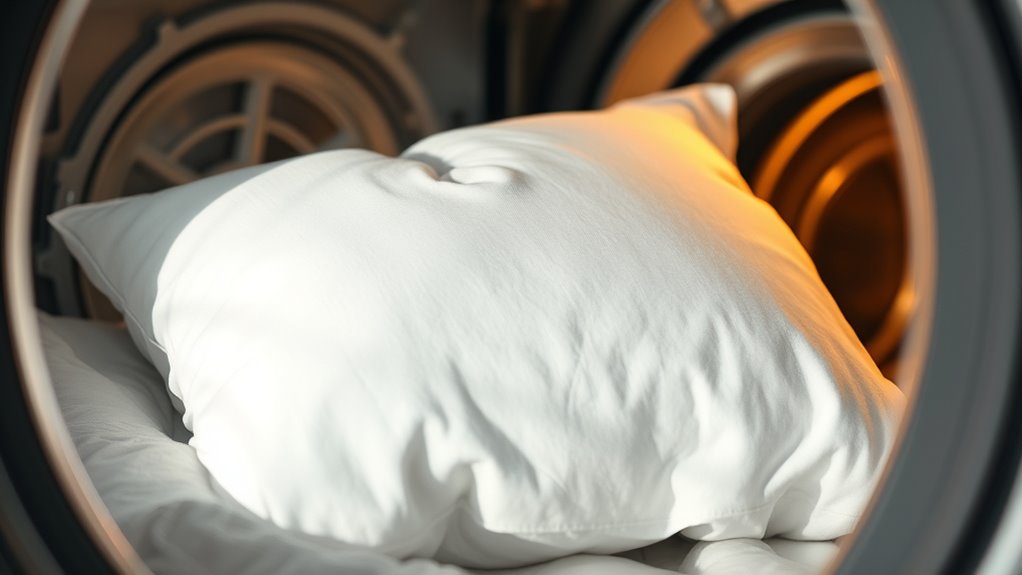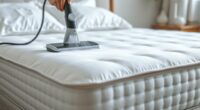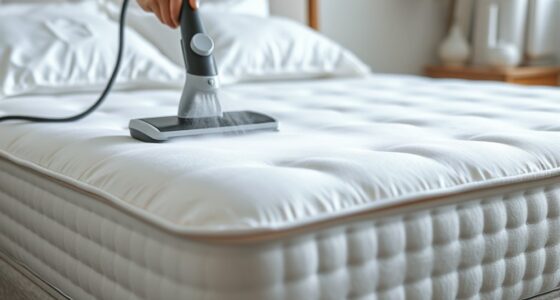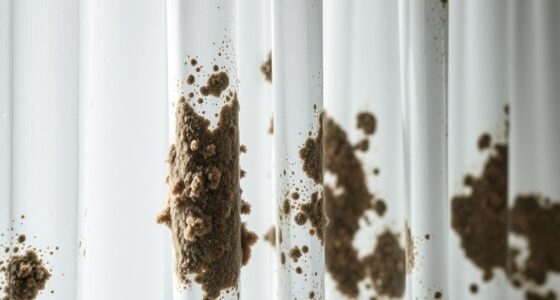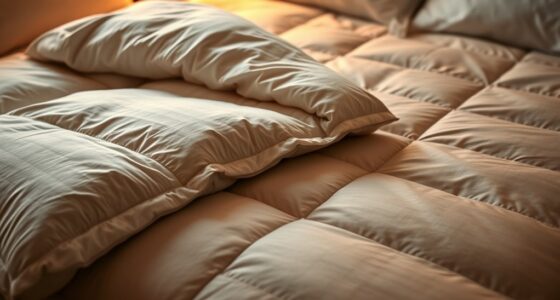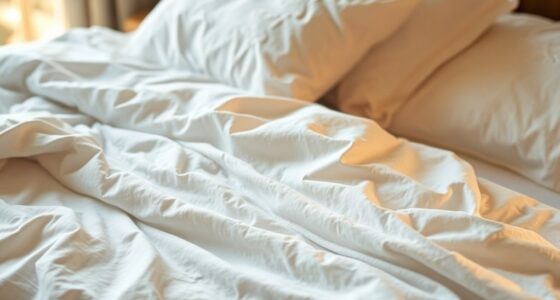To wash your pillows properly, check the care label first and use a gentle cycle with warm water and a small amount of mild detergent. Wash two pillows at a time, rinse thoroughly, and gently squeeze out excess water. Dry them on low heat with dryer balls or air-dry in a sunny spot, flipping regularly. Make sure they’re completely dry before use to avoid mold. Keep going to discover simple tips for perfect pillow care.
Key Takeaways
- Always check the care label and handle pillows according to their material type.
- Wash pillows in pairs with mild detergent on a gentle cycle using warm water.
- Rinse thoroughly to remove all detergent residue and gently squeeze out excess water.
- Dry pillows on low heat in a dryer with tennis balls or air-dry in a sunny, well-ventilated area.
- Ensure pillows are completely dry before use to prevent mold, bacteria, and odor buildup.
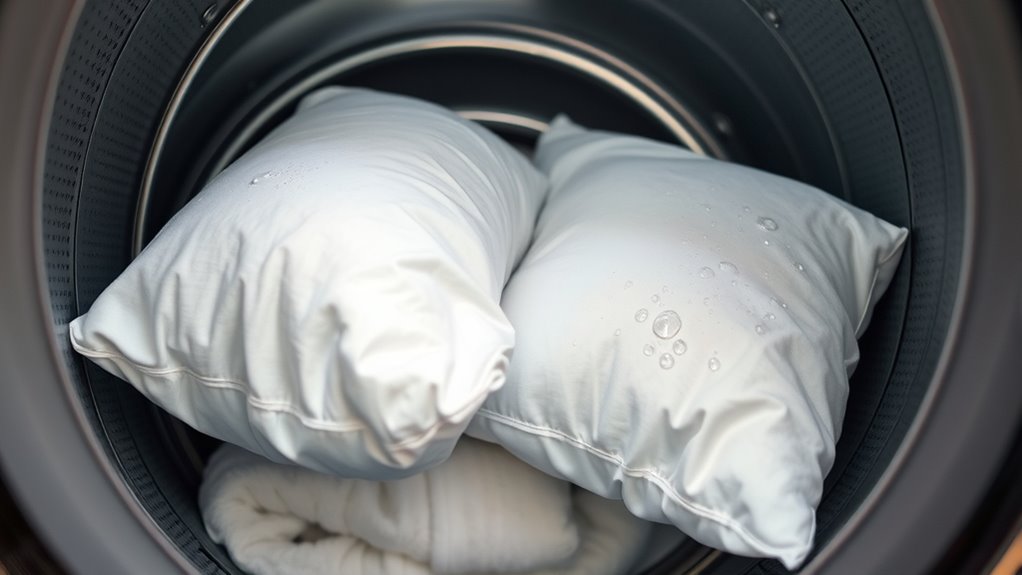
Washing your pillows is an vital step to maintain a clean and healthy sleeping environment. Over time, pillows gather dust mites, sweat, oils, and bacteria, which can lead to allergies, skin breakouts, or a less restful sleep. Regular cleaning not only prolongs the life of your pillows but also guarantees you’re sleeping on a fresh, sanitary surface. The key is to wash them properly and, just as importantly, dry them thoroughly. Skipping the drying process or rushing through it can cause mold, mildew, or foul odors to develop, defeating the purpose of cleaning.
Regularly washing pillows keeps your sleeping environment clean and healthy.
When it’s time to wash your pillows, start by checking the care label. Different materials and fillings require specific handling. Most synthetic pillows are machine washable, while memory foam or latex pillows usually need spot cleaning or special care. If your pillow is machine washable, use a gentle cycle with warm water to effectively remove dirt and oils without damaging the fill. Adding a small amount of mild detergent is usually enough—avoid harsh chemicals or bleach, which can weaken the fabric or irritate your skin. To balance the load and prevent the pillow from getting compressed, wash two pillows at a time if possible.
After washing, it’s vital to rinse thoroughly to remove any remaining detergent, as residue can cause irritation or attract more dirt. Once the cycle finishes, give your pillows a good squeeze to expel excess water, but don’t wring them out—this can distort their shape. Instead, gently press or roll them to remove moisture. The next critical step is drying. You should use a dryer on low heat or air-dry your pillows in a well-ventilated space. Toss a couple of clean tennis balls or dryer balls into the dryer to help fluff the pillows and prevent clumping of the filling. If you prefer air drying, lay your pillows flat in a sunny spot, flipping them regularly to ensure even drying. It can take several hours for pillows to dry completely, and leaving them damp can lead to mold growth.
Never skip the drying step or rush it by using high heat, as this can damage the pillow’s fill or fabric. Damp pillows are a breeding ground for mold and bacteria, which compromises your health and shortens the pillow’s lifespan. Make sure they’re thoroughly dry before putting them back on your bed. With proper washing and drying, your pillows will stay fresh, supportive, and safe for a good night’s sleep.
Frequently Asked Questions
How Often Should I Wash My Pillows for Optimal Hygiene?
You should wash your pillows every 3 to 4 months for ideal hygiene. Regular washing removes dust mites, allergens, and sweat buildup that can cause allergies or skin irritation. Use hot water if possible, and dry them thoroughly to prevent mold. If you notice stains or odors earlier, don’t hesitate to wash them sooner. Consistent cleaning helps keep your sleep environment fresh, clean, and healthy.
Can I Wash Memory Foam Pillows in the Washing Machine?
You shouldn’t wash memory foam pillows in the washing machine because they can be damaged or lose their shape. Instead, spot clean with a mild detergent and a damp cloth. If you want a thorough clean, hand wash the pillow gently in a bathtub with cool water and mild soap, then let it air dry completely. Avoid wringing or using a dryer to preserve the foam’s integrity.
What Detergents Are Best for Cleaning Pillows?
Surprisingly, you don’t need a fancy detergent to clean your pillows. A mild liquid detergent works best, especially one free of harsh chemicals and fragrances that can irritate your skin. Avoid bleach and strong detergents, which can break down pillow fibers. Use a gentle cycle and extra rinse to verify all soap is gone, leaving your pillows fresh without damage. Simple, right? Your pillows will thank you.
How Do I Remove Stains From My Pillows Effectively?
To remove stains from your pillows effectively, first identify the stain type. For most stains, create a mixture of equal parts water and gentle detergent, then apply it directly to the stain. Gently scrub with a soft brush or cloth, letting it sit for 15 minutes. Rinse thoroughly with clean water, then wash your pillow as usual. Repeat if needed for stubborn stains, ensuring your pillow stays fresh and clean.
Is It Safe to Tumble Dry All Types of Pillows?
Did you know that around 80% of people dry their pillows in the dryer? While tumble drying is generally safe for most pillows, check the label first. Feather and down pillows can sometimes get damaged or lose fluff, so use a low heat setting. Memory foam or latex pillows shouldn’t go in the dryer at all—they could warp or break. Always follow manufacturer instructions to keep your pillows in top shape.
Conclusion
So, wash your pillows regularly, refresh your sleep, and protect your health. Dry them thoroughly, prevent mold, and extend their lifespan. Keep them clean, keep them comfortable, and keep them inviting. Taking these simple steps guarantees you wake up feeling rested, refreshed, and ready to face the day. Remember, clean pillows aren’t just about comfort—they’re about caring for yourself. Make pillow maintenance a habit, and enjoy better sleep every night.
